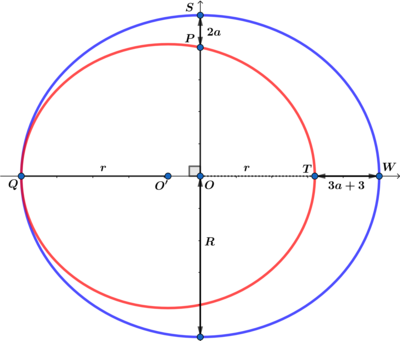Ratio of Circles

Let a > 0 .
In the above diagram the larger circle centered at O has radius R and the smaller circle centered at O ′ , which is tangent to the larger circle at Q , has radius r and P S = 2 a and T W = 3 a + 3 .
If R + r = 9 1 and there are two values of a which correspond to two areas between the two circles say A 1 and A 2 , where A 2 > A 1 , and A 1 A 2 = β α , where g cd ( α , β ) = 1 , find α + β .
The answer is 101.
This section requires Javascript.
You are seeing this because something didn't load right. We suggest you, (a) try
refreshing the page, (b) enabling javascript if it is disabled on your browser and,
finally, (c)
loading the
non-javascript version of this page
. We're sorry about the hassle.
1 solution
Just a minor simplification, due to the form of the answer you're looking for: A i = π ( R i 2 − r i 2 ) = π ( R i + r i ) ( R i − r i ) = 2 3 × 9 1 π ( a i + 1 ) , so that the ratio we need is just A 2 A 1 = a 2 + 1 a 1 + 1 .
That's Very Nice. Thanks!
You meant A 2 A 1 = a 2 + 1 a 1 + 1
Using the diagram above we have:
2 R = 2 r + 3 a + 3 ⟹ R = r + 2 3 a + 3 ⟹ R = r + 2 3 a + 3 = O P + 2 a ⟹ O P = r − ( 2 a − 3 ) and O ′ O = 2 3 ( a + 1 ) .
∴ In right △ P O O ′ we have r 2 − ( a − 3 ) r + 4 ( a − 3 ) 2 + 4 9 ( a + 1 ) 2 = r 2
⟹ r = 4 1 ( a − 3 9 ( a + 1 ) 2 + a − 3 ) = 2 ( a − 3 ) 5 a 2 + 6 a + 9
⟹ R = 2 ( a − 3 ) 5 a 2 + 6 a + 9 + 2 3 a + 3 = 2 ( a − 3 ) 8 a 2
⟹ R + r = 2 ( a − 3 ) 8 a 2 + 2 ( a − 3 ) 5 a 2 + 6 a + 9 = 9 1
⟹ 1 3 a 2 + 6 a + 9 = 1 8 2 a − 5 4 6 ⟹ 1 3 a 2 − 1 7 6 a + 1 5 5 = 0 ⟹
( a − 5 ) ( 1 3 a − 1 1 1 ) = 0 ⟹
a 1 = 5 , a 2 = 1 3 1 1 1
a 1 = 5 ⟹ R = 4 2 0 0 = 5 0 and r = 4 1 6 4 = 4 1 ⟹ A 1 = π ( 5 0 2 − 4 1 2 ) = 8 1 9 π
and
a 2 = 1 3 1 1 1 ⟹ R = 1 8 7 2 9 8 5 6 8 = 2 3 4 1 2 3 2 1 and r = 1 8 7 2 7 1 7 8 4 = 2 3 4 8 9 7 3
⟹ A 2 = π ( 2 3 4 2 1 2 3 2 1 2 − 8 9 7 3 2 ) = 5 4 7 5 6 7 1 2 9 2 3 1 2 = 1 3 0 2 π
⟹ A 1 A 2 = 3 9 ∗ 2 1 π 6 2 ∗ 2 1 π = 3 9 6 2 = β α ⟹ α + β = 1 0 1 .